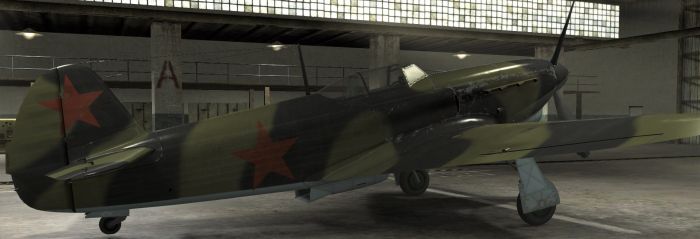Yak-1b series 127
Jump to navigation
Jump to search
The Yakovlev Yak-1b series 127 is a collector fighter of IL-2 Sturmovik: Great Battles.
Hangar view
Important facts and figures
Engine management
- The engine has been tuned to never go higher than nominal power. You can therefore fly all day with every lever jammed forwards, провинциал style.
- The only limit to engine power output is heat soak. Careful radiator and mixture management will be key here.
- Radiators exert minimum drag when fully closed.
- On the deck: 80% mixture for performance, 90% is overrich and cools the engine. For every 1000m above 2000m, reduce these numbers by about 5% (ie: 75% at 3000m, 70% at 4000m, etc)
- In first supercharger gear, power output peaks below maximum engine RPM. On the deck this is at 2550 RPM. This changes with altitude: hold the throttle steady and observe at what RPM the manifold pressure peaks. Maximum RPM allows for maximum acceleration; maximum power for maximum speed.
- In second supercharger gear, jam that RPM lever all the way forwards!
- Shift supercharger gears at 2000m (earlier than the manual calls for).
- Engine water temperature should be kept between 70°C and 85°C. Don't exceed 100°C.
- Engine oil temperature should be kept between 90°C and 100°C. Don't exceed 115°C.
Airspeed considerations
- Vne: 720Km/h.
- Stall speed without flaps: 153-169km/h.
- Stall speed with flaps: 132-145km/h.
- Stock flat out top speed at sea level: 530km/h.
Flying the Yak-1b
Out of combat
Startup and taxi
- RPM, mixture 100%.
- Throttle 10-15%.
- Begin engine startup sequence.
- Unlike every other Yak, for taxiing, the tailwheel is unlocked by pressing your rudder pedals through more than 75% of their travel. Avoid stomping on the pedals if you want to remain in control on the ground.
Takeoff
- Make sure your tailwheel is locked.
- Mixture to 80%
- Open the radiators for the initial climb to altitude: oil at around 25%, water at around 45%.
- Smoothly throttle up to full power.
- Use left rudder to keep the plane straight, but not too much, or you'll unlock the tail wheel.
- Takeoff speed is just under 200km/h.
Climb
- Pitch trim to achieve the desired attitude.
- Keep an eye on your oil and water temperature and adjust the radiator flaps if necessary.
- Dont forget to shift your supercharger gear at 2000m (earlier than the manual calls for).
- Lean the mixture by around 5% for every 1000m you climb higher than 2000m (ie: 75% at 3000m, 70% at 4000m, etc).
Cruise
- Pitch trim to achieve the desired attitude.
- Keep an eye on your oil and water temperature and adjust the radiator flaps if necessary. You may need to close them more than you think!
- If you wish to save fuel, lean your mixture until your exhaust is no longer sooty.
- If necessary, adjust your RPM for maximum speed.
Landing
- RPM to 100%.
- Mixture to 80%.
- Keep an eye on your oil and water temperature and adjust the radiator flaps if necessary. You may need to close them more than you think!
- The pneumatic flap actuators can only exert enough force to extend the flaps under 220km/h. And even then, the flaps won't fully extend. Expect them to suddenly extend as your speed drops, with the usual effects on handling.
- Landing speed is around 140km/h.
- After touchdown, let the plane roll for a little while before applying the brakes.
In combat
Overall
- RPM to 100% for dogfighting.
- RPM to peak power output for BnZ or when chasing or fleeing.
- Mixture to 80%. Use 90% if your engine is getting hot. Adjust these numbers according to altitude!
- Keep an eye on your oil and water temperature and adjust the radiator flaps if necessary. The only limit to how hard you can run your engine is how hot is gets. You can also choose to close your rads to allow for short bursts of lower drag.
Strengths
- Perfect rear visibility.
- Decent energy retention.
- Fastest Yak flat out.
Weaknesses
- Sub-par armament, specifically, the cannon ammo is garbage. 2 shells out of 3 are AP and thus do little to enemy planes.
- Punishing instant turn: if you pull slightly too hard on the stick, one wing will stall and the plane will snap roll over.
- Loses pitch authority above 550km/h.



